Pieter Neeffs the Younger stands as a significant figure in the rich tapestry of 17th-century Flemish Baroque painting. Active primarily in the bustling artistic hub of Antwerp, he carved a distinct niche for himself, specializing in the meticulous and atmospheric depiction of church interiors. Following in the footsteps of his accomplished father, Neeffs the Younger dedicated his career to capturing the grandeur, solemnity, and intricate architectural beauty of sacred spaces, leaving behind a legacy of works admired for their technical precision and evocative handling of light.
The Neeffs Dynasty and Early Training
Born in Antwerp and baptized on May 23, 1620, Pieter Neeffs the Younger was destined for a life in art. He was the son of the highly regarded architectural painter Pieter Neeffs the Elder (c. 1578 – after 1656), who had already established a successful workshop specializing in church interiors. It was within this familial environment, steeped in the principles of perspective and architectural rendering, that the younger Pieter received his foundational training. He learned the craft directly from his father, absorbing the techniques and thematic focus that would define his own artistic output.
The Neeffs workshop was a family affair. Pieter the Younger worked alongside his father, and his brother Ludovicus Neeffs (born 1617) also trained there, though Ludovicus later pursued a religious path, becoming a monk. The elder Neeffs had become a master in the Antwerp Guild of Saint Luke in 1609 or 1610, establishing the family's professional standing. While the exact date of Pieter the Younger's entry into the Guild as an independent master is less certain, it is clear he operated within the established framework of his father's successful practice, contributing to and eventually continuing the family's specialized production.
This familial context is crucial for understanding Pieter Neeffs the Younger's development. He inherited not only techniques but also a specific artistic lineage and a ready-made market for detailed church views. His early work, inevitably, shows a strong connection to his father's style, making attribution between the two sometimes challenging for art historians.
The Influence of Masters: Steenwijck and Neeffs the Elder
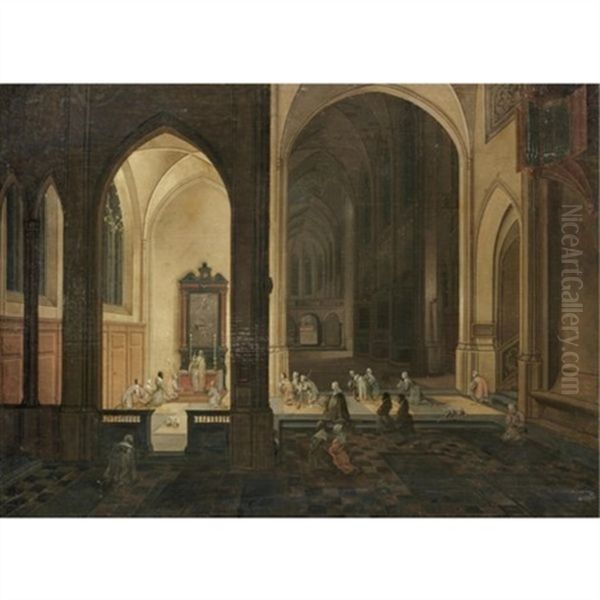
The artistic style perfected by the Neeffs family did not emerge in a vacuum. Pieter Neeffs the Elder himself was significantly influenced by the pioneering work of Hendrick van Steenwijck the Elder (c. 1550–1603) and his son, Hendrick van Steenwijck the Younger (c. 1580–1649). The Steenwijcks were among the earliest artists in the Low Countries to specialize in architectural interiors as an independent genre, moving away from using them merely as backdrops for historical or biblical scenes. They mastered linear perspective to create convincing illusions of deep, receding spaces within church naves and aisles.
Pieter Neeffs the Elder adopted and adapted the Steenwijck model, often favouring views of Antwerp's own Gothic churches. He became particularly known for his night scenes, dramatically lit by candles or torches, a motif likely inspired by Hendrick van Steenwijck the Younger. Pieter Neeffs the Younger, in turn, inherited this stylistic blend. His works demonstrate the same commitment to architectural accuracy and the sophisticated use of perspective pioneered by the Steenwijcks and refined by his father.
Specifically, the influence of Hendrick van Steenwijck the Younger is often noted in Pieter the Younger's handling of artificial light in nocturnal church scenes. The careful rendering of flickering candlelight casting long shadows across flagstone floors and illuminating vaulted ceilings owes much to the established conventions of the genre, which the younger Neeffs adeptly mastered and personalized throughout his career. He built upon the foundations laid by these predecessors, contributing to the evolution of architectural painting in Antwerp.
Specialization: The Gothic Interior
The core subject of Pieter Neeffs the Younger's oeuvre was the church interior, predominantly rendered in the Gothic style. While he occasionally depicted imaginary or composite architectural spaces, many of his most recognizable works are based on actual churches in Antwerp, most notably the city's grand Cathedral of Our Lady and the Church of St. Paul (formerly the Dominican church). This focus reflected a broader trend in the Low Countries, where detailed depictions of local landmarks, including churches, found favour among patrons.
These paintings served multiple purposes. They were demonstrations of artistic virtuosity, showcasing the painter's command of complex perspective and detail. They also functioned as objects of civic pride and religious devotion, capturing the magnificence of Antwerp's ecclesiastical architecture, particularly significant in the context of the Catholic Counter-Reformation which saw renewed investment in church decoration and art. The soaring vaults, slender columns, intricate tracery, and ornate furnishings of Gothic churches provided rich visual material.
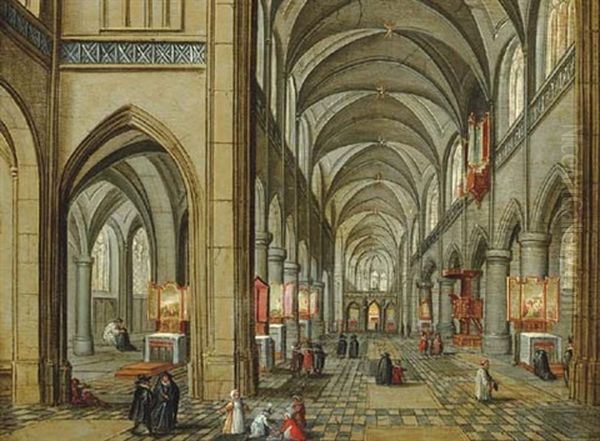
Neeffs the Younger excelled at conveying the scale and spatial complexity of these structures. His compositions often employ a central vanishing point, drawing the viewer's eye deep into the choir or down a long nave. He paid meticulous attention to architectural elements, rendering capitals, arches, and ribbed vaults with precision. This detailed approach often extended to the depiction of altarpieces, tombs, and stained-glass windows, providing valuable visual records of church interiors as they appeared in the 17th century. His works frequently feature small figures, which serve to animate the space and give a sense of scale.
Light, Shadow, and Atmosphere
A defining characteristic of Pieter Neeffs the Younger's art is his skillful manipulation of light and shadow (chiaroscuro) to create atmosphere and enhance the sense of three-dimensionality. He explored various lighting conditions, producing both sunlit daytime interiors and evocative nocturnal scenes. In his daytime views, light often streams through tall Gothic windows, illuminating specific areas while leaving others in relative shadow, highlighting the architectural forms and creating a dynamic interplay across surfaces.
His night scenes are particularly noteworthy. Following the tradition influenced by Hendrick van Steenwijck the Younger, Neeffs depicted church interiors illuminated by the warm, localized glow of candles or torches. This allowed for dramatic contrasts between brightly lit areas and deep, mysterious shadows, imbuing the sacred spaces with a sense of intimacy, solemnity, or even theatricality. The flickering light source often becomes a focal point, drawing attention to a specific ritual, like the celebration of Mass, or simply emphasizing the vastness of the surrounding darkness.
Compared to some of his predecessors, Neeffs the Younger's palette could sometimes be slightly cooler or employ more subtle tonal transitions, but his fundamental aim remained the convincing representation of light behaving within an enclosed architectural space. Whether depicting the diffuse light of day or the concentrated glow of a candle, his handling of light was crucial in defining form, creating depth, and establishing the particular mood of each scene. This mastery of light contributes significantly to the enduring appeal of his paintings.
The Art of Collaboration: Staffage Painters
In 17th-century Antwerp, specialization was common practice among artists. Painters often focused on specific genres or elements within a painting, leading to frequent collaborations. Pieter Neeffs the Younger, like his father, was primarily an architectural specialist. While capable of rendering figures, the small human forms (known as staffage) that populate his church interiors were frequently painted by other artists who specialized in figure painting. This collaborative approach allowed each artist to contribute their specific expertise, resulting in a highly finished final product.
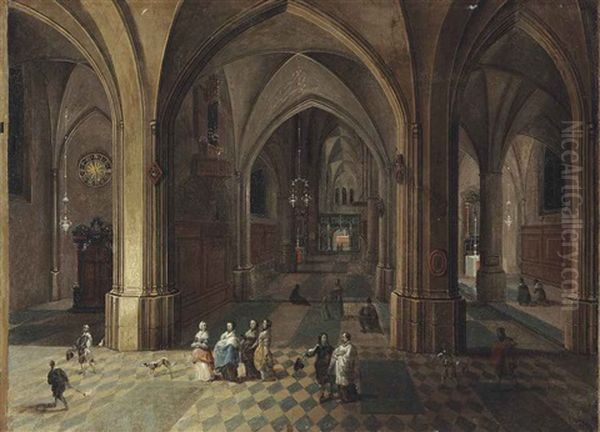
Historical records and stylistic analysis indicate that Neeffs the Younger collaborated with several prominent figure painters of his time. Among the most frequently cited collaborators are members of the prolific Francken dynasty, particularly Frans Francken the Younger (1581–1642) – who also worked with Neeffs the Elder – and Frans Francken III (1607–1667). Jan Brueghel the Younger (1601–1678), another leading Antwerp artist known for his detailed figures and landscapes, is also mentioned as a collaborator.
Other artists potentially involved in adding staffage to Neeffs' works might include David Teniers the Elder (1582–1649) or even figures associated with genre scenes like Hieronymus Janssens (1624–1693) or Gonzales Coques (1614/18–1684), although collaborations with the Francken family and Brueghel seem most common. These figures are not merely decorative; they add life, narrative context (depicting Mass, processions, or casual visitors), and crucially, a sense of scale that emphasizes the grandeur of the architecture. This practice highlights the interconnected nature of the Antwerp art market.
Distinguishing Father and Son
One of the persistent challenges for art historians studying the Neeffs family is distinguishing the work of Pieter Neeffs the Elder from that of Pieter Neeffs the Younger. Both artists shared the same specialization, worked in a very similar style, depicted the same Antwerp churches, and often signed their works simply "Pieter Neeffs," sometimes adding "the Elder" or "the Younger" (or variants like "den oude" / "de jonge"), but not consistently. Furthermore, they worked together for many years, potentially on the same canvases.
Generally, some scholars suggest that the father's work might exhibit a slightly warmer palette and perhaps a finer, more detailed execution, while the son's work might occasionally appear somewhat cooler in tone or slightly broader in handling. However, these distinctions are subtle and debated. Some sources suggest the son's skill was comparable to his father's, while others deem his work slightly less refined. The presence of signatures or dates can help, but many works are unsigned or undated.
The situation is further complicated by the existence of Ludovicus Neeffs, the other son, who also painted in the family style before joining a monastery. Although fewer works are attributed to him, his hand might also be present in the large body of work associated with the Neeffs workshop. Consequently, attributions often remain tentative, with many works catalogued as "Pieter Neeffs the Elder or Younger" or "Workshop of Pieter Neeffs." Despite these difficulties, a distinct body of work is generally accepted as being by Pieter Neeffs the Younger, particularly paintings dated after his father would likely have ceased working.
Representative Works and Collections
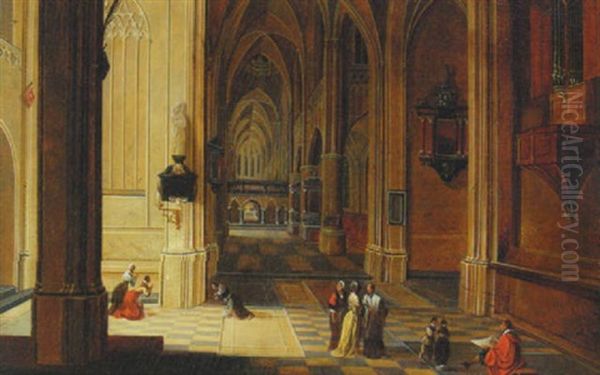
Pieter Neeffs the Younger's dedication to architectural interiors resulted in a considerable output, many examples of which survive today in major museum collections worldwide. His works consistently showcase his command of perspective, detail, and atmospheric lighting. Among his representative paintings are numerous views of the interior of Antwerp Cathedral and St. Paul's Church in Antwerp, depicted under varying light conditions and populated by figures engaged in different activities.
Specific examples often attributed to him include Interior of a Gothic Church by Night, sometimes noted as a collaboration with Frans Francken, which exemplifies his skill in nocturnal scenes. Paintings titled Church Interior with Figures or similar, dated to the 1640s and later, often showcase his mature style. The Presbytery (c. 1650), based on Antwerp Cathedral, highlights his ability to render specific, recognizable architectural spaces with precision. His depictions often include details like priests celebrating Mass, elegantly dressed citizens conversing, or beggars seeking alms, adding social and narrative dimensions.
Works by Pieter Neeffs the Younger can be found in prestigious institutions such as the Metropolitan Museum of Art in New York, the National Gallery in London, the National Gallery of Art in Washington D.C., the State Hermitage Museum in St. Petersburg, the Rijksmuseum in Amsterdam, the Prado Museum in Madrid, and the Royal Museums of Fine Arts of Belgium in Brussels. His paintings hang alongside those of other Flemish masters like Peter Paul Rubens, Anthony van Dyck, Jacob Jordaens, and David Teniers the Younger, underscoring his significance within the Antwerp school.
Legacy and Influence
Pieter Neeffs the Younger played a crucial role in consolidating and continuing the tradition of architectural painting in Flanders during the 17th century. Building on the innovations of the Steenwijcks and the established reputation of his father, he produced a consistent body of high-quality work that catered to the contemporary taste for detailed, illusionistic depictions of recognizable or idealized sacred spaces. His mastery of perspective and light remained influential within the genre.
While perhaps not as innovative as the very first generation of architectural specialists, Neeffs the Younger maintained a high standard of craftsmanship throughout his career, which extended at least into the mid-1670s (he died sometime after 1675). His focus on Gothic interiors, rendered with atmospheric sensitivity, contributed significantly to the visual identity of Flemish Baroque art. The collaborative nature of his practice also exemplifies the efficient, specialized production methods prevalent in the Antwerp art world.
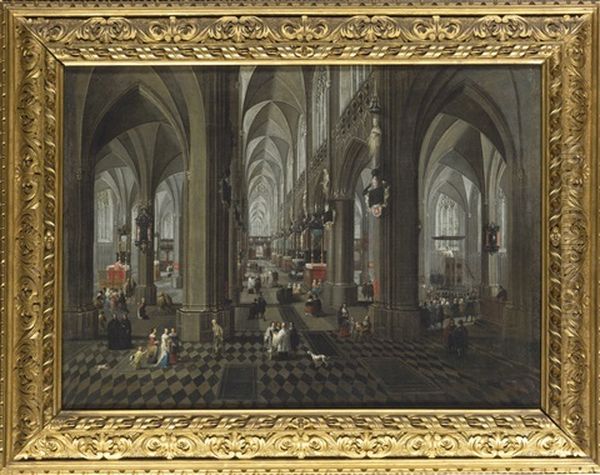
His work, along with his father's, helped solidify the church interior as a respected independent genre. Later architectural painters active in Antwerp, such as Anton Ghering (fl. 1662) or Wilhelm Schubert van Ehrenberg (1630–c. 1676), continued to explore similar themes, inheriting the technical approaches refined by the Neeffs family. Today, Pieter Neeffs the Younger's paintings are valued not only as exquisite examples of architectural painting but also as historical documents offering glimpses into the appearance and use of Antwerp's great churches during the Baroque era.
Conclusion
Pieter Neeffs the Younger remains a distinguished painter of the Flemish Baroque, celebrated for his specialized focus on church interiors. As the inheritor of a family tradition deeply influenced by pioneers like the van Steenwijcks, he mastered the art of rendering complex Gothic architecture with remarkable perspectival accuracy and sensitivity to light. His numerous depictions of Antwerp's churches, often created in collaboration with skilled figure painters like the Franckens and Jan Brueghel the Younger, capture both the monumental scale and the intimate atmosphere of these sacred spaces. Though sometimes overshadowed by his father or facing attribution challenges, his substantial body of work confirms his status as a key practitioner of architectural painting, whose meticulous and evocative canvases continue to fascinate viewers in museums around the world. His art provides a lasting window onto the visual and spiritual world of 17th-century Antwerp.